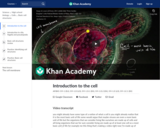
Introduction to the cell.
- Subject:
- Biology
- Life Science
- Material Type:
- Lesson
- Provider:
- Khan Academy
- Provider Set:
- Khan Academy
- Author:
- Sal Khan
- Date Added:
- 11/29/2017

Introduction to the cell.
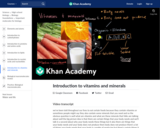
Overview of common vitamins and minerals that are important to human health.
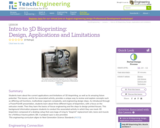
Students learn about the current applications and limitations of 3D bioprinting, as well as its amazing future potential. This lesson, and its fun associated activity, provides a unique way to review and explore concepts such as differing cell functions, multicellular organism complexity, and engineering design steps. As introduced through a PowerPoint® presentation, students learn about three different types of bioprinters, with a focus on the extrusion model. Then they learn the basics of tissue engineering and the steps to design printed tissues. This background information prepares students to conduct the associated activity in which they use mock-3D bioprinters composed of a desktop setup that uses bags of icing to “bioprint” replacement skin, bone and muscle for a fictitious trauma patient, Bill. A pre/post-quiz is also provided.
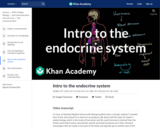
Basic overview of hormones and the endocrine system. Created by Sal Khan.
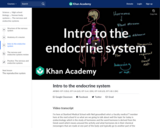
Basic overview of hormones and the endocrine system.
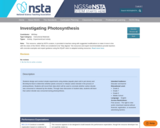
Students design and conduct simple experiments using elodea (aquatic plant sold in pet stores) and Bromthymol blue to determine whether plants consume or release carbon dioxide in the process of photosynthesis. Students will record their data which will be used to conclude whether carbon dioxide was consumed or released by the elodea. Through class discussion of student data, students will learn that carbon dioxide was consumed during photosynthesis.
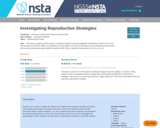
Students work in pairs to compare five aspects of an organism that reproduces sexually, asexually, or both sexually and asexually. The activity comes with a chart for the students to fill out and with information sheets on twelve organisms. As a class, students share their comparisons and generate a list of general characteristics for each mode of reproduction and then discuss the advantages and disadvantages of both. Included in the discussion are reproductive mechanisms and genetic variation.
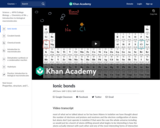
Ionic bonds result from the electrostatic attraction between oppositely charged ions, which form when valence electrons are transferred from one atom to another. Created by Sal Khan.
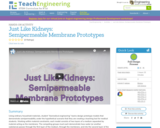
Using ordinary household materials, student “biomedical engineering” teams design prototype models that demonstrate semipermeability under the hypothetical scenario that they are creating a teaching tool for medical students. Working within material constraints, each model consists of two layers of a medium separated by material acting as the membrane. The competing groups must each demonstrate how water (or another substance) passes through the first layer of the medium, through the membrane, and into the second layer of the medium. After a few test/evaluate/redesign cycles, teams present their best prototypes to the rest of the class. Then student teams collaborate as a class to create one optimal design that reflects what they learned from the group design successes and failures. A pre/post-quiz, worksheet and rubric are provided.
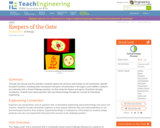
Through two lessons and five activities, students explore the structure and function of cell membranes. Specific transport functions, including active and passive transport, are presented. In the legacy cycle tradition, students are motivated with a Grand Challenge question. As they study the ingress and egress of particles through membranes, students learn about quantum dots and biotechnology through the concept of intracellular engineering.
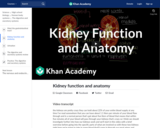
Brief overview of kidney function and anatomy.
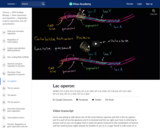
Overview of gene regulation in the Lac operon. Discussion of CAP, cAMP, lac repressor and allolactose in regulation of lac operon.
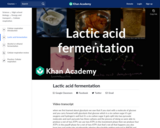
Lactic acid fermentation. How organisms like lactobacillus convert pyruvic acid to lactic acid and oxidize NADH to NAD+ in the process.

In this video profile produced for Teachers' Domain, meet La'ona DeWilde, an environmental biologist who integrates her Athabascan heritage and her Western scientific training to help remote Alaskan villages address environmental issues.

LeBron James asks Sal Khan about which muscles we use when we shoot a basket. Created by Sal Khan and LeBron James.
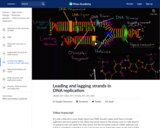
Roles of DNA polymerase, primase, ligase, helicase and topoisomerase in DNA replication. An explanation of leading and lagging strands.
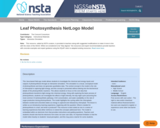
This Java-based NetLogo model allows students to investigate the chemical and energy inputs and outputs of photosynthesis through an interactive simulation. The simulation is a visual, conceptual model of photosynthesis and does not generate quantitative data. The central concept in the model is the role of chlorophyll in capturing light energy, and this concept is presented without delving into the biochemical details of the photosynthetic reactions. This allows students to focus on the core idea that photosynthesis transforms light energy into chemical energy. Along with exploring the basic process of photosynthesis, students can investigate the effects of light intensity, the day-night cycle (assuming the most common C3 photosynthetic pathway), CO2 concentration, and water availability on the rate of sugar production during photosynthesis. The model highlights the cycling within the chloroplasts between excited and unexcited states as energy is captured and released by chlorophyll. The lesson is written as an introductory learning experience, beginning with the question: What is needed for photosynthesis in a leaf, and what is produced? This resource is best suited as one in a series of learning experiences that either reinforce or extend the concepts addressed here. The model is embedded within an electronic form that provides instructions and guiding questions. Teachers and students should note that the electronic form does not save user data. An important limitation is that the model relies heavily on students visual perception, and this may pose a barrier for some students.
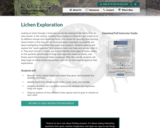
Looking at lichen through a hand lens can be like looking at life-forms from an alien planet. In this activity, students focus closely on lichen and get turned on to its different strange and interesting forms. One reason for spending time learning about lichens is that they can be found just about anywhere, so students can keep investigating lichen after they leave your program. Students observe and explore this “weird organism” that grows on rocks and trees and wonder what it is. They learn that it’s a lichen, use a key to identify three types of lichen, reflect on the symbiotic relationship of fungi and algae that make up lichens, and finally search for evidence of lichen succession. After this activity, students will likely begin to notice lichens everywhere, and will be motivated to continue their explorations.
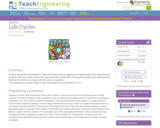
In this lesson, students will extend their knowledge of matter and energy cycles in an organism to engineering life cycle assessment of a product. Students will learn about product life cycle assessment and the flow of energy through the cycle, comparing it to the flow of nutrients and energy in the life cycle of an organism.
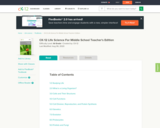
CK-12 Life Science Honors For Middle School covers seven units: Understanding Living Things; Cells: The Building Blocks of Life; Genetics and Evolution; Prokaryotes, Protists, Fungi, and Plants; The Animal Kingdom; The Human Body; and Ecology.